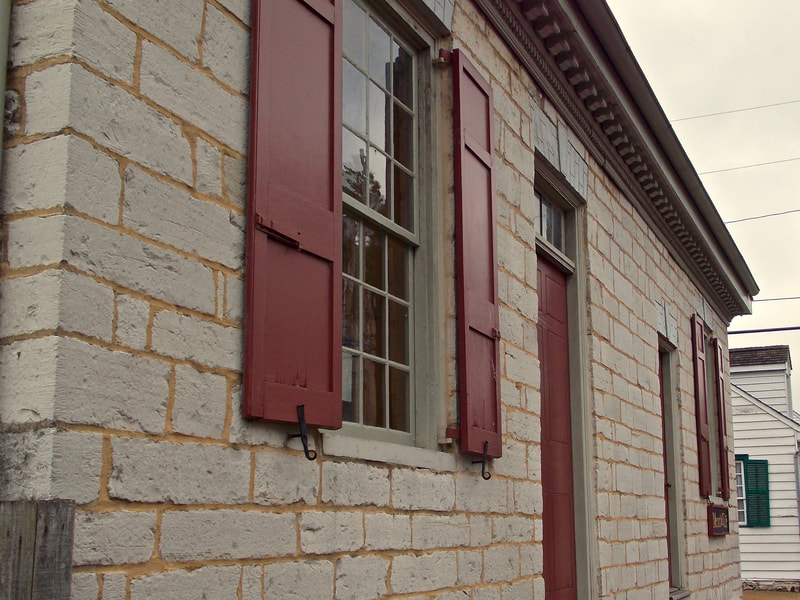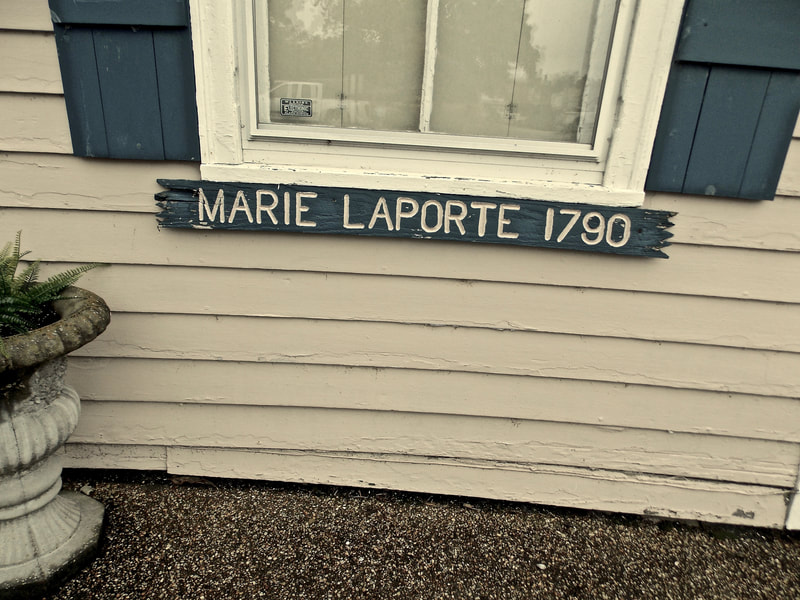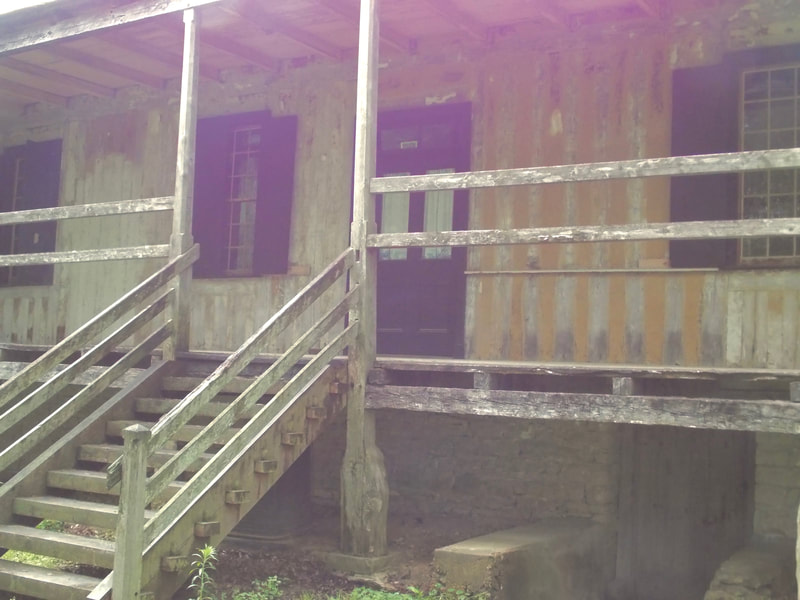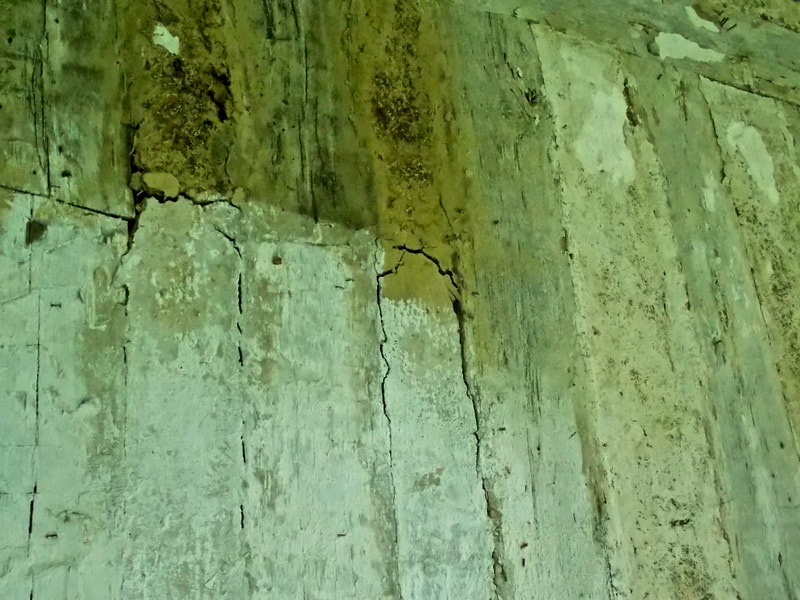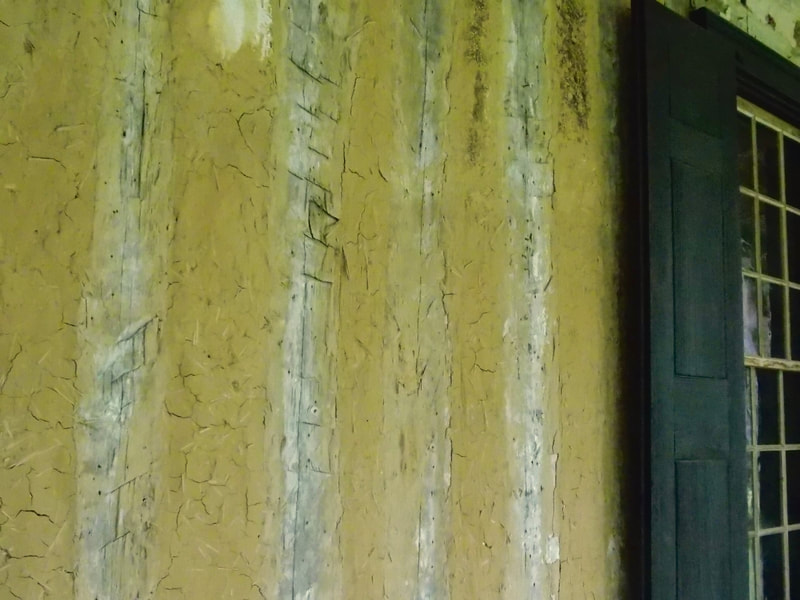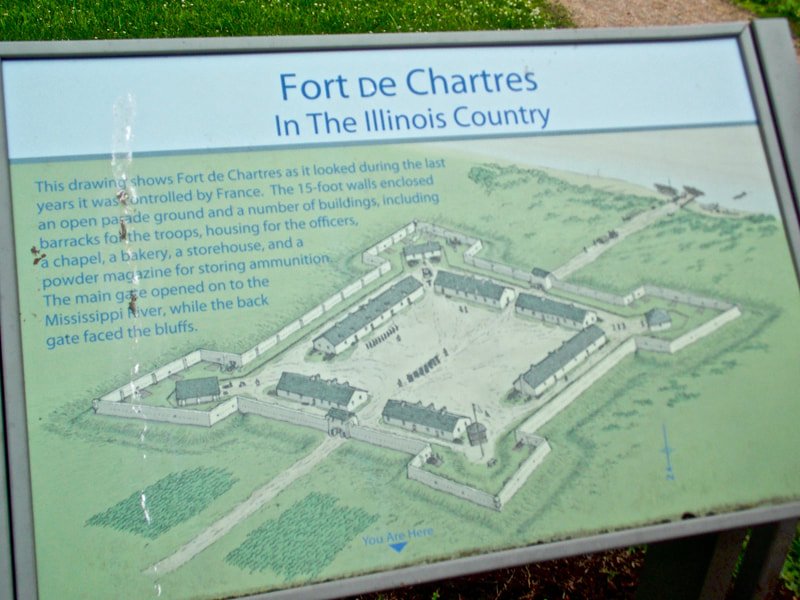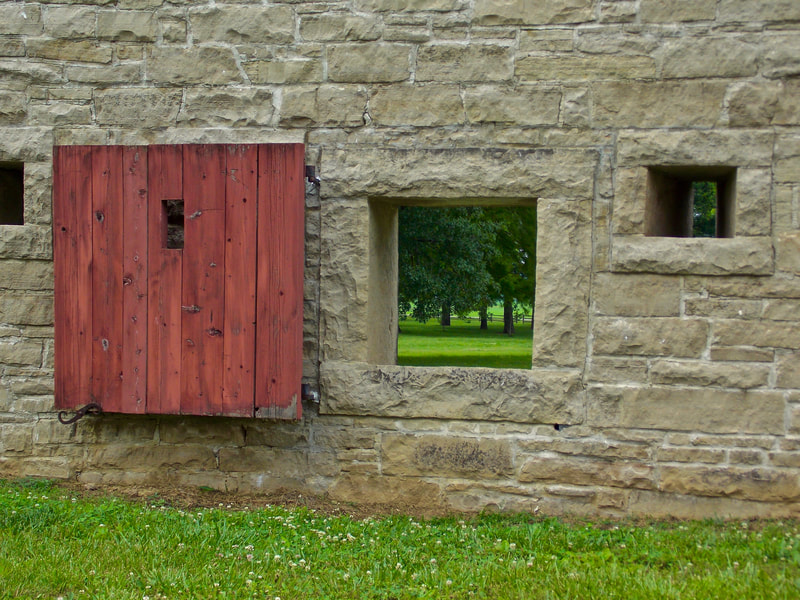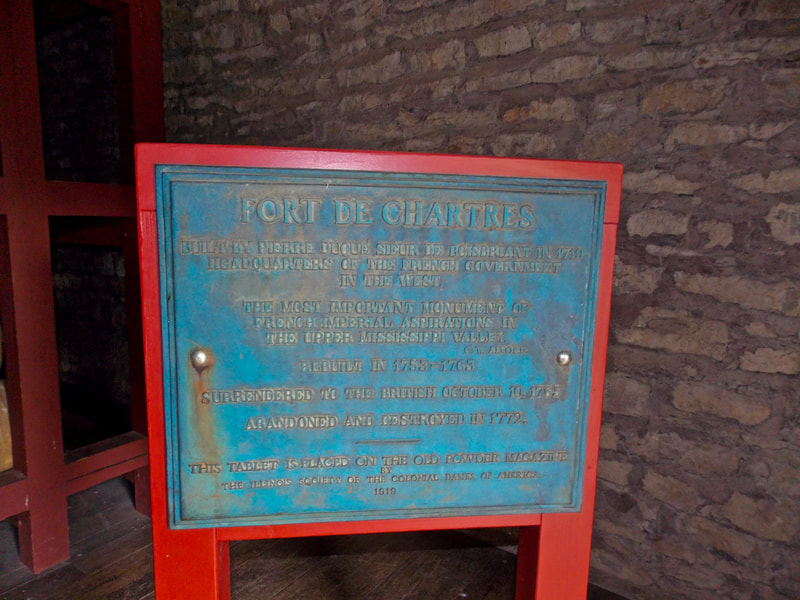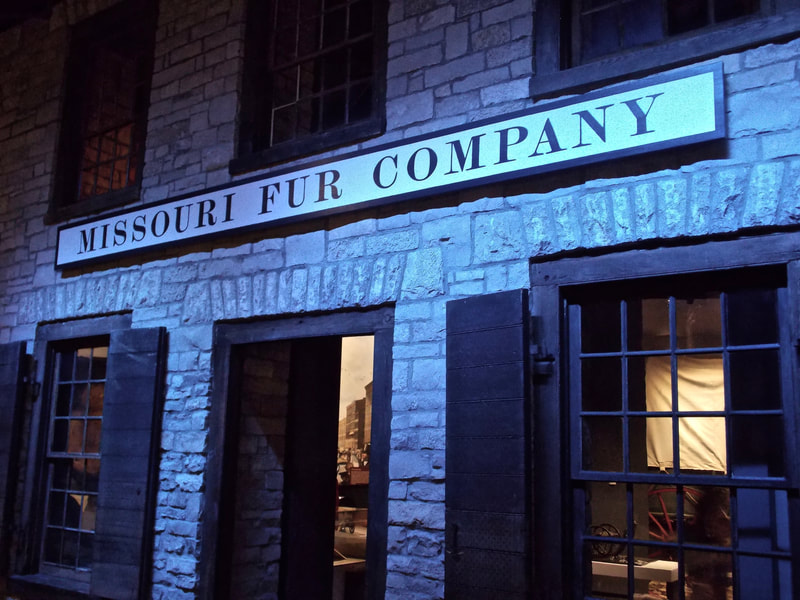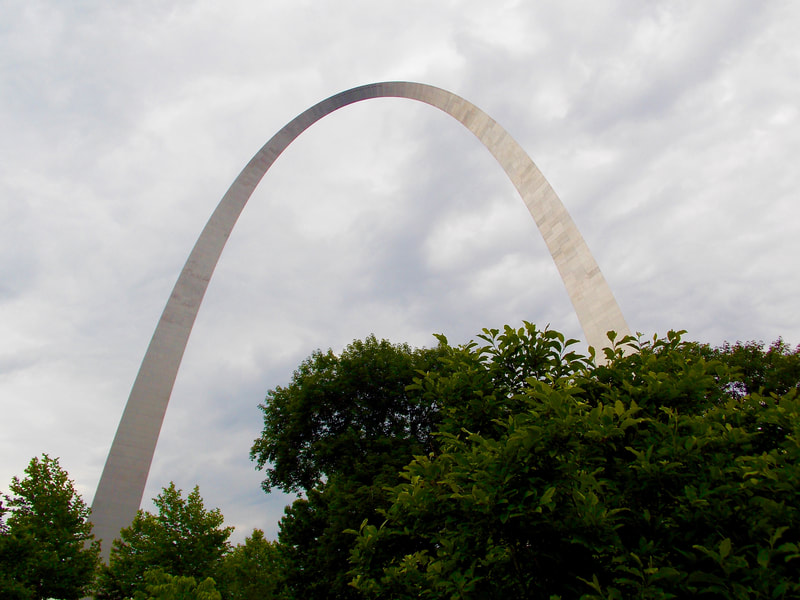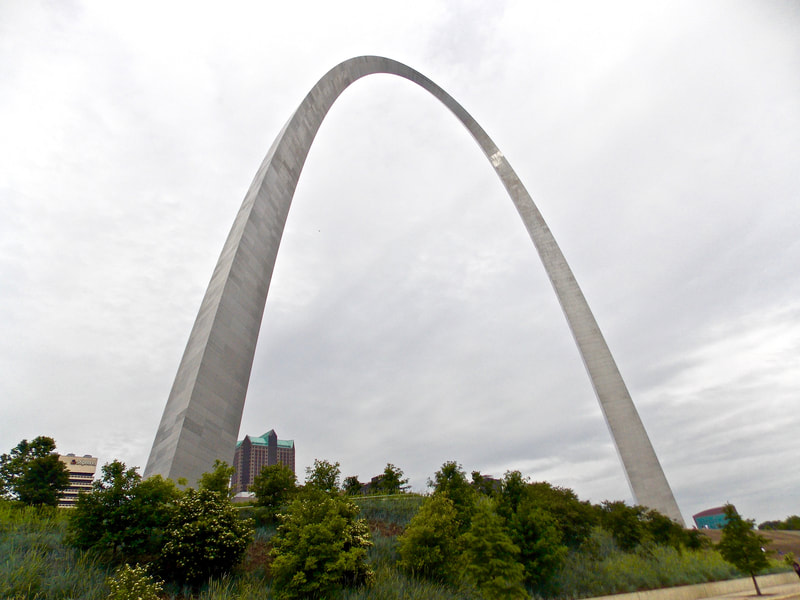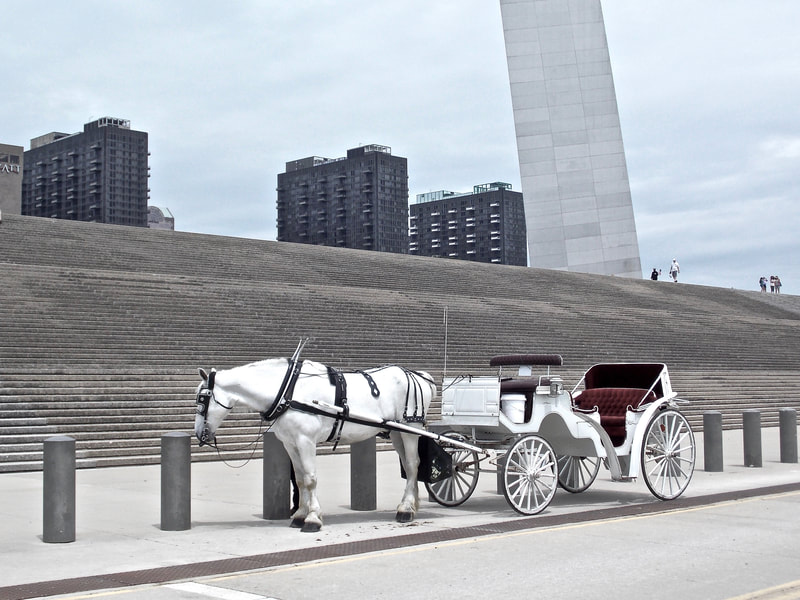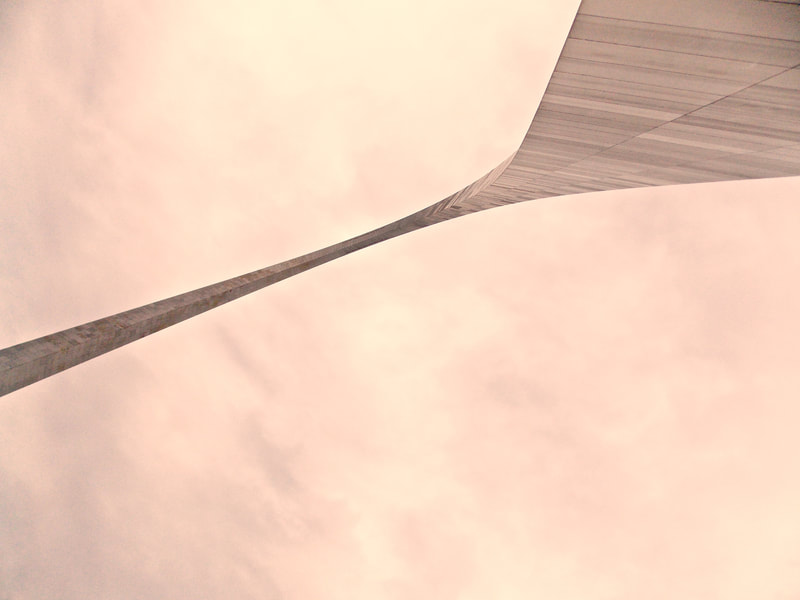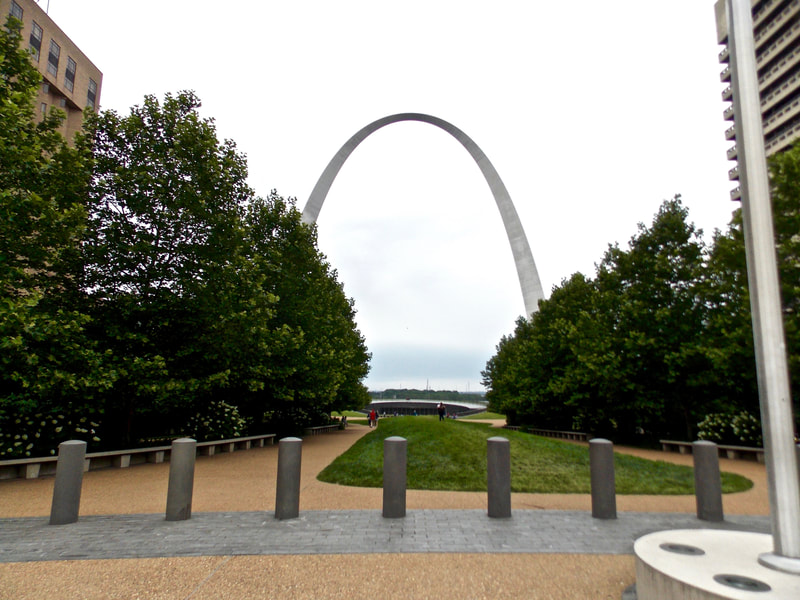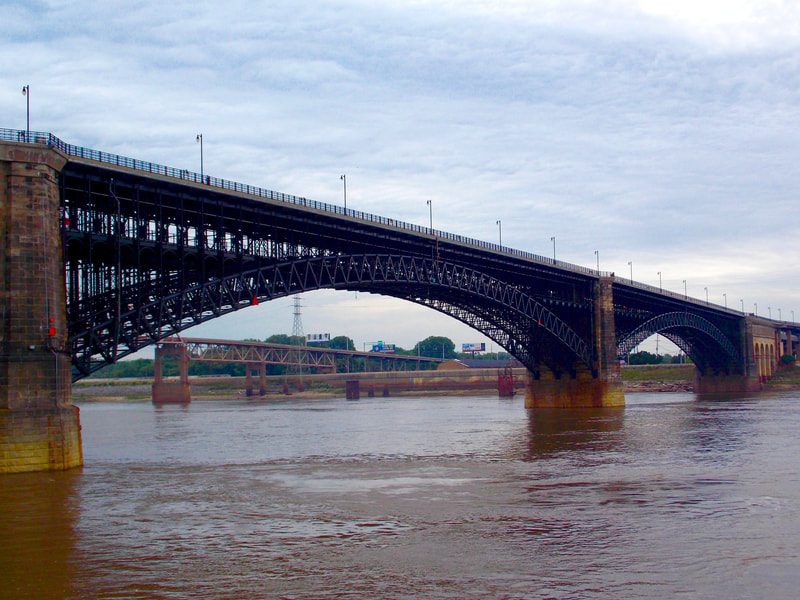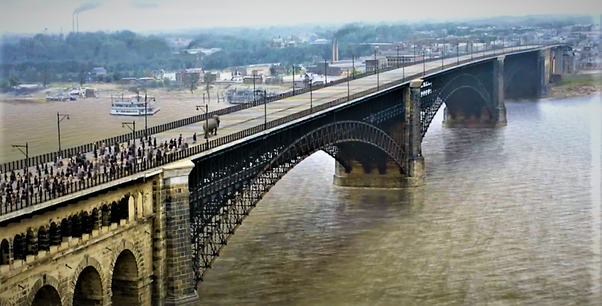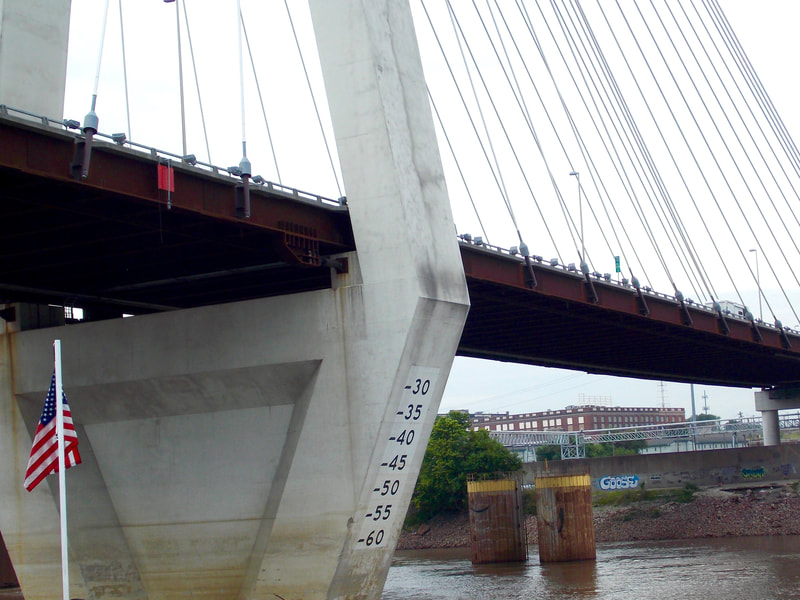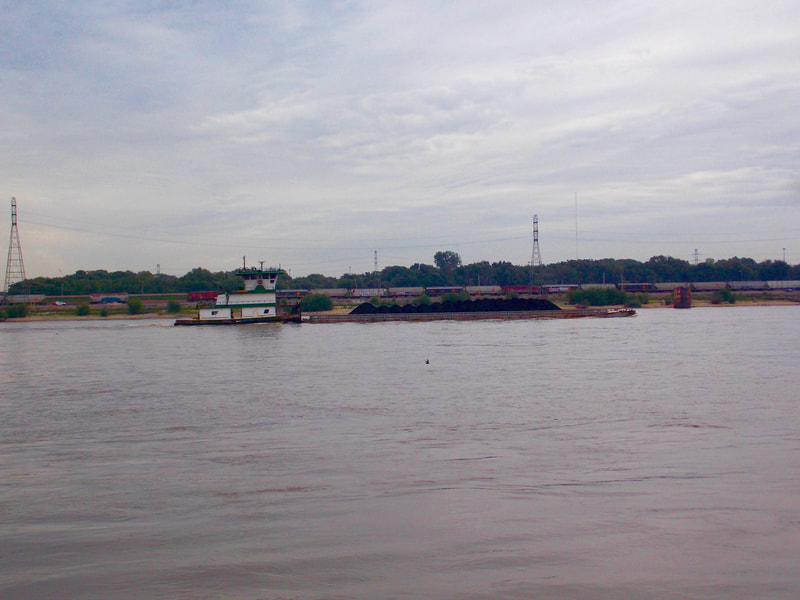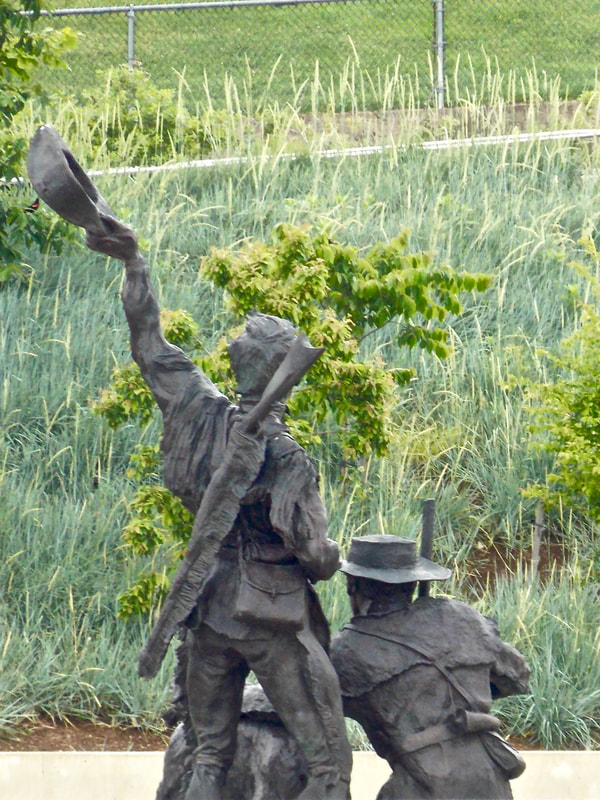We didn't let that stop us from walking around and seeing some of the architecture with a French Colonial influence. The high-peaked roofs, the rock walls, and the vertical logs are distinctive to the period and the region. One building, now a restaurant, displays a sign claiming it is the first brick building west of the Mississippi River, built in 1785.
|
I really expected more from our visit to Ste. Genevieve, but the town was still pretty sleepy from its winter nap. We felt like we had the place to ourselves. While that's pleasant in some situations, we would rather have had some guidance or even costumed interpreters. We didn't let that stop us from walking around and seeing some of the architecture with a French Colonial influence. The high-peaked roofs, the rock walls, and the vertical logs are distinctive to the period and the region. One building, now a restaurant, displays a sign claiming it is the first brick building west of the Mississippi River, built in 1785. We were here on after some rain, so the town was still glistening and quiet. We especially appreciated the addition of the Fleur de lis on various locations, including street signs, as a nod to the region's French roots.
0 Comments
When we consolidated activities, we were able to take an extra excursion with Ste. Genevieve, Missouri, as our destination. For any readers who aren't aware, this is the first permanent settlement west of the Mississippi River. My goal was to finally get a peek at some architecture from before Missouri statehood. Unfortunately, much of the town does not wake up from hibernation until the first weekend in June, and we were there the weekend before that. One shop that was working was ASL Pewter where I met Thomas Hooper. Hooper showed me how to take a sheet of pewter to make round pewter boxes on a lathe. He used two wooden rods to center and shape the pewter, which was taken to completion in just a few seconds. Other items like the little salt spoons pictured below require stamping. Hooper has set up at trade shows, including on the lawn at George Washington's Mount Vernon, but with age and other issues, he would rather people visit him in the shop at Ste. Genevieve. If not, one might choose to shop online, as well.
He mentioned that Thomas Jefferson is one who brought pewter work to the American colonies as a less expensive and easily produced item for skilled tradesmen to make and sell - probably quite a bit easier to manipulate than the silver work that Paul Revere was known to make.  Yesterday, notification arrived that I have been awarded this honor. Two students nominated me for the National History Teacher of the Year award earlier in the school year. Not knowing if I would be worthy of the award, I participated in the application process, answering questions, completing a resumé, securing a recommendation letter from the principal, and submitting a 15-page series of lessons and activities to show how we do things in our classroom. Here is what the press release looks like right now: [Mr.] Hoggatt, a teacher at Cecil Floyd Elementary School in Joplin, has been named the 2021 Missouri History Teacher of the Year, an award presented annually by the Gilder Lehrman Institute of American History, the nation's leading organization dedicated to K-12 American history education. That all being said, when I see the devotion and the energy of previous winners - all the major projects they have instigated and worked through - I am humbled. Watch last year's presentation, with the award being presented by Lynn Manuel-Miranda. While I am not a member of prestigious history organizations, and while I have not racked up awards and fellowships from around the world, I am still a teacher. For 32 years now, my focus has been on honing my teaching skills and connecting with elementary students. A lot of energy has been burned on making the setting of my classroom safe for everybody who enters - especially safe in a way that allows vulnerable and open discussion among people who might disagree. Our class is a family, and I wouldn't have it any other way.
We were headed south to explore French-Colonial Missouri, when we discovered that the courthouse in Cahokia wasn't very far off the highway. It's not every day that you get to see a log cabin with vertical logs, so why not go see it? Here's what the National Park Service tells us about this building:
Not only this, but the courthouse was taken apart in 1901 to be displayed in the 1904 World's Fair before being taken to Chicago a couple of years later. The World's Fair was billed as a celebration of the 100th anniversary of the Corps of Discovery (Lewis and Clark Expedition. Residents of Cahokia, Illinois brought the courthouse home in 1939.
Fort de ChartresWikipedia notes, "About five miles northeast of Ste. Genevieve on the east side of the river was Fort de Chartres (in the Illinois Country); it stood as the official capital of the area." The fort has been rebuilt twice, and the current site displays reconstructed walls. Inside the walls, however, is the powder magazine - an original building that has been restored. The powder magazine, pictured below in the last five photos, is said to be the oldest building in Illinois.
Fleur De LisHere is the Old Courthouse, site of the infamous Dred Scott trial (and others, less infamous). The courthouse sits in the shadow of the Gateway Arch and provides some contrast between the conquest of the West and the plight of African-Americans who were still enslaved in the mid-1800s. Visitors can still see the staircase and the courtroom where Dred Scott laid out the case for his freedom. That is, they could still see those things if the courthouse was open. Right now and for a while, the courthouse is closed for renovations. Still, we love seeing and imagining this bit of history in the middle of the bustling city of St. Louis.
Originally Posted July 3, 2020 Is this right? Is this a list of things students do not learn in school? If not, why not? I think we do a pretty good job of addressing many of the things in this list:
 The author of this list is unknown, but the list has been published online by a Christian-based publisher that I follow and read. I can't be sure of the goal in publishing this list - probably something to encourage homeschooling - but I am happy to say that I try to cover these issues in our class each year. Along with soft skills and asserting your ideas respectfully, these are the kinds of things schools should be including in their social skills, civics, history, science, communication, and career readiness classes. These make up at least part of a message about personal responsibility. Why wouldn't students learn these in school? Perhaps there is a political message here, as well; I suppose that is possible. Maybe someone is asserting in this list that you are not entitled to something that you do not deserve or earn. I don't know if that is political or not. We used to call this, if you didn't learn it early, the School of Hard Knocks. It's probably best that you learn this now, and not wait until you expect something that you're not going to get. Yes, be a child while you are a child - live in Neverland for a while longer - but realize that there will come a time when you have to step up to the plate, toe the line, and work hard.
The history of the Mississippi valley is one that coincides with what we think of as American history. While Jamestown and Plymouth were the sites of English colonization, it was around the same period that the French were exploring the Mississippi River and the lands that surrounded it. That means there is a largely untold history here (Just look for popular books on the subject.), and it one that helps us better understand the events of the French and Indian War and the Revolution. The museum at the Gateway Arch has greatly changed since the last time we were there. The update suits me well, as it begins during the French Colonial period and describes the events of the French and Indian and Revolutionary Wars. These are not the occurrences we usually study, but they were happening at the same time, and they do maintain a certain amount of perspective. The French side of things sometimes gets lost as we pit the Redcoats against the Patriots.
I also found the mention of Thomas Jefferson's dad to be interesting, when projection described that he was interested in settling and exploring the West. I guess I've not put much thought into Jefferson's dad, but this intrigued me. It is even more fitting that Jefferson himself became the one who made possible the Louisiana Purchase from France and then sent explorers to scout out his purchase. As usual, I am more interested in getting to see authentic artifacts and not replicas and reproductions and there were enough of these to satisfy me on our visit. I took pictures of a peace pipe and a George Washington peace medal that caught my attention. Still, I love that revolving book stand that Jefferson is famous for (even if this one was a reproduction). NIt's the tallest National Monument in our collection. Twice as tall as the Statue of Liberty Almost a hundred feet taller than the Washington Monument. It's another engineering wonder in St. Louis. With concrete aiding the support for only the first 300 feet, the upper part of the Arch has no inner support. There is no skeleton for this stainless steel beauty.
It was all water under the bridge on our Tom Sawyer riverboat cruise. We crossed most of these bridges on the highways at some point on our St. Louis trip, but this was our only opportunity to cross under them. The most visibly historic of all the bridges is the Eads Bridge pictured here.
According to my friend, author Ross Malone, on June 14, 1874, "A big crowd of onlookers cheered as a 'test elephant' was led across Eads Bridge...People believed that elephants could somehow sense whether or not a structure could support its weight. Eventually Eads ran 14 locomotives back and forth across the bridge while inspectors looked for signs of stress." This is pictured in the photo above (source unknown). This bridge now provides light rail service on the St. Louis Metrolink, as well as a walking/bicycling trail, in addition to motorized-vehicle traffic. Other bridges, built more recently, offer completely different engineering methods. The most prominent being a bridge that is suspended and supported by huge cables and pylons. These bridges support a great deal of traffic going in and out of the city between Missouri and Illinois. At some point, about halfway across, is the state line.
IN CONGRESS, July 4, 1776. The unanimous Declaration of the thirteen united States of America, When in the Course of human events, it becomes necessary for one people to dissolve the political bands which have connected them with another, and to assume among the powers of the earth, the separate and equal station to which the Laws of Nature and of Nature's God entitle them, a decent respect to the opinions of mankind requires that they should declare the causes which impel them to the separation. We hold these truths to be self-evident, that all men are created equal, that they are endowed by their Creator with certain unalienable Rights, that among these are Life, Liberty and the pursuit of Happiness.--That to secure these rights, Governments are instituted among Men, deriving their just powers from the consent of the governed, --That whenever any Form of Government becomes destructive of these ends, it is the Right of the People to alter or to abolish it, and to institute new Government, laying its foundation on such principles and organizing its powers in such form, as to them shall seem most likely to effect their Safety and Happiness. Prudence, indeed, will dictate that Governments long established should not be changed for light and transient causes; and accordingly all experience hath shewn, that mankind are more disposed to suffer, while evils are sufferable, than to right themselves by abolishing the forms to which they are accustomed. But when a long train of abuses and usurpations, pursuing invariably the same Object evinces a design to reduce them under absolute Despotism, it is their right, it is their duty, to throw off such Government, and to provide new Guards for their future security.--Such has been the patient sufferance of these Colonies; and such is now the necessity which constrains them to alter their former Systems of Government. The history of the present King of Great Britain is a history of repeated injuries and usurpations, all having in direct object the establishment of an absolute Tyranny over these States. To prove this, let Facts be submitted to a candid world. He has refused his Assent to Laws, the most wholesome and necessary for the public good. He has forbidden his Governors to pass Laws of immediate and pressing importance, unless suspended in their operation till his Assent should be obtained; and when so suspended, he has utterly neglected to attend to them. He has refused to pass other Laws for the accommodation of large districts of people, unless those people would relinquish the right of Representation in the Legislature, a right inestimable to them and formidable to tyrants only. He has called together legislative bodies at places unusual, uncomfortable, and distant from the depository of their public Records, for the sole purpose of fatiguing them into compliance with his measures. He has dissolved Representative Houses repeatedly, for opposing with manly firmness his invasions on the rights of the people. He has refused for a long time, after such dissolutions, to cause others to be elected; whereby the Legislative powers, incapable of Annihilation, have returned to the People at large for their exercise; the State remaining in the mean time exposed to all the dangers of invasion from without, and convulsions within. He has endeavoured to prevent the population of these States; for that purpose obstructing the Laws for Naturalization of Foreigners; refusing to pass others to encourage their migrations hither, and raising the conditions of new Appropriations of Lands. He has obstructed the Administration of Justice, by refusing his Assent to Laws for establishing Judiciary powers. He has made Judges dependent on his Will alone, for the tenure of their offices, and the amount and payment of their salaries. He has erected a multitude of New Offices, and sent hither swarms of Officers to harrass our people, and eat out their substance. He has kept among us, in times of peace, Standing Armies without the Consent of our legislatures. He has affected to render the Military independent of and superior to the Civil power. He has combined with others to subject us to a jurisdiction foreign to our constitution, and unacknowledged by our laws; giving his Assent to their Acts of pretended Legislation: For Quartering large bodies of armed troops among us: For protecting them, by a mock Trial, from punishment for any Murders which they should commit on the Inhabitants of these States: For cutting off our Trade with all parts of the world: For imposing Taxes on us without our Consent: For depriving us in many cases, of the benefits of Trial by Jury: For transporting us beyond Seas to be tried for pretended offences For abolishing the free System of English Laws in a neighbouring Province, establishing therein an Arbitrary government, and enlarging its Boundaries so as to render it at once an example and fit instrument for introducing the same absolute rule into these Colonies: For taking away our Charters, abolishing our most valuable Laws, and altering fundamentally the Forms of our Governments: For suspending our own Legislatures, and declaring themselves invested with power to legislate for us in all cases whatsoever. He has abdicated Government here, by declaring us out of his Protection and waging War against us. He has plundered our seas, ravaged our Coasts, burnt our towns, and destroyed the lives of our people. He is at this time transporting large Armies of foreign Mercenaries to compleat the works of death, desolation and tyranny, already begun with circumstances of Cruelty & perfidy scarcely paralleled in the most barbarous ages, and totally unworthy the Head of a civilized nation. He has constrained our fellow Citizens taken Captive on the high Seas to bear Arms against their Country, to become the executioners of their friends and Brethren, or to fall themselves by their Hands. He has excited domestic insurrections amongst us, and has endeavoured to bring on the inhabitants of our frontiers, the merciless Indian Savages, whose known rule of warfare, is an undistinguished destruction of all ages, sexes and conditions. In every stage of these Oppressions We have Petitioned for Redress in the most humble terms: Our repeated Petitions have been answered only by repeated injury. A Prince whose character is thus marked by every act which may define a Tyrant, is unfit to be the ruler of a free people. Nor have We been wanting in attentions to our British brethren. We have warned them from time to time of attempts by their legislature to extend an unwarrantable jurisdiction over us. We have reminded them of the circumstances of our emigration and settlement here. We have appealed to their native justice and magnanimity, and we have conjured them by the ties of our common kindred to disavow these usurpations, which, would inevitably interrupt our connections and correspondence. They too have been deaf to the voice of justice and of consanguinity. We must, therefore, acquiesce in the necessity, which denounces our Separation, and hold them, as we hold the rest of mankind, Enemies in War, in Peace Friends. We, therefore, the Representatives of the united States of America, in General Congress, Assembled, appealing to the Supreme Judge of the world for the rectitude of our intentions, do, in the Name, and by Authority of the good People of these Colonies, solemnly publish and declare, That these United Colonies are, and of Right ought to be Free and Independent States; that they are Absolved from all Allegiance to the British Crown, and that all political connection between them and the State of Great Britain, is and ought to be totally dissolved; and that as Free and Independent States, they have full Power to levy War, conclude Peace, contract Alliances, establish Commerce, and to do all other Acts and Things which Independent States may of right do. And for the support of this Declaration, with a firm reliance on the protection of divine Providence, we mutually pledge to each other our Lives, our Fortunes and our sacred Honor. The 56 signatures on the Declaration appear in the positions indicated:
Cruising up and down the Mississippi River on the Tom Sawyer riverboat was a pleasant way to spend a morning. The weather was a little iffy when we boarded, but we didn't need our umbrellas after all. This "Tom Cruise" started with a loud blast of the horn. The boat took off going upriver. For most of the excursion, we sat on the top deck and listened to the narration from the captain. He described many of the things we were seeing along the shorelines, both to the left in Missouri and to the right in Illinois. We understood a little bit more than before about the barges and tugs that frequent this important river, and for most of the ride, we had a resoundingly industrial view. The river was about 10 feet above normal, so debris that had washed from the shore upriver was still floating downriver.
We opted not to spend money on the helicopter tour, but it does sound like something that would be interesting and thrilling to try in the future.
Some of the panels in this graphic novel are quite artistic, but most are very bland instead. There is not much action, but instead, many panels are just closeups of characters' faces. Other than that the story is a classic telling of a teenaged Jewish girl forced into hiding when Nazi soldiers roundup students in her school. Much like the historic figure, Anne Frank, people supply her with food while she hides. Also like Anne Frank, the girl falls in love with one of her benefactors.
The story is simple enough, and I was buying into the whole concept. This is the backstory for one of the character's in the best-selling Wonder. The boy in that book appears in this one, as well, when he video calls his grandmother and asks her about her life story, which turns into the the frightening hideout situation. It's a decent telling, but I never could find a purpose in it being told through the panels of a graphic novel.
Then there is the last section, when the book returns to Julian and his grandmère. Sara hangs up from her call with Julian after telling him that people fail to learn from history and they stand around when they could join together and fight back against injustices. Picking up a newspaper, she is overwhelmed by the headlines. Somehow this author has equated the graphic slaughter of six million people during the Holocaust with Former President Trump's policies. In a single panel of her book, she shoves a bold political statement into faces of her readers. Suddenly building a wall, separating immigrant children from their parents, anti-semitism and "Islamophobia" are all blamed on a single person without any consideration of context. The "oppression" of other groups is also called into question in a protest. It is a call to action, entirely promoted by the author. While she doesn't promote it, she also does not draw the line between protests and rioting. I can say that I didn't like the original Wonder story, but White Bird would have been fine (though not at all original); unfortunately, the inclusion of current politics really ruined it for me. In the back material following the story, another author even makes a statement that whether the reader agrees with Palacio's partisan depiction of current events, you must agree to her conclusions. Here's the second of the 2021/2 Mark Twain Award nominees, and I'm still waiting to be impressed. |
AnthemThe Hoggatteer Revolution
is an extensive, award-winning, inimitable, digital platform for Encouraging and Developing the Arts, Sciences, and honest Christianity in the beautiful, friendly LAND OF THE FREE AND THE HOME OF THE BRAVE This site is described as
"a fantastic site... chockablock full of interesting ideas, hilarious anecdotes, and useful resources." 
...to like, bookmark, pin,
tweet, and share about the site... and check in regularly for new material, posted often before DAWN'S EARLY LIGHT! History in ResidenceElementary Schools: Bring Mr. Hoggatt into your classroom for a week of engaging and rigorous history programming with your students. LEARN MORE BUILDING BETTER
|









